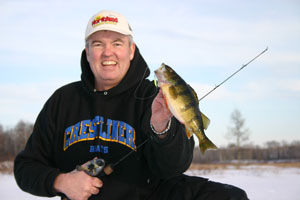First ice is made for hooking up with more than walleyes.  Sure it can be good (even great), but a little diversity might round out
the perfect plan. Walleyes are notorious for turning on during low
light periods, especially when fishing shallow water early in the
season. Activity during the day can be almost nonexistent Rather than
pressing the daytime issue you might have more fun by switching target
species and chasing down a bunch of jumbo perch.
Sure it can be good (even great), but a little diversity might round out
the perfect plan. Walleyes are notorious for turning on during low
light periods, especially when fishing shallow water early in the
season. Activity during the day can be almost nonexistent Rather than
pressing the daytime issue you might have more fun by switching target
species and chasing down a bunch of jumbo perch.
Most good walleye waters also produce decent perch,
with some that fall into the desirable ďjumboĒ category. Mille Lacs
Lake in central Minnesota can do it, so can Lake of the Woods, Eire as
well. Devilís lake in North Dakota used to, but things have changed.
According to Team Crestliner member Johnny Candle: ďThe lake is overrun
with walleyes right now which has taken its toll on the perch. Theyíre
getting gobbled up and the perch fishing isnít what is used to be. On
the other hand the walleye action is incredible.Ē The thing to keep in
mind is that lakes go through cycles and there are peaks and valleys in
both size and numbers, and if you can hit it when itís right youíll have
a ball.
The most important key to cashing in on early
season perch (and walleyes) is location. Fortunately for those
primarily chasing walleyes the hot perch spots usually arenít that much
different, and can even be the very same. Itís just that the timing is
different. Walleyes will typically be most active early in the morning
and late in the day over the top of shallower rock and gravel bars, and
along shoreline breaks and deeper weed edges. When theyíre in they rule
the roost, at least when it comes to perch. When theyíre out the perch
take over and have free run of the place. It doesnít happen immediately
though, and you may have to wait for a few hour or more before the
jumbos start to show up.
Midday is probably a safe bet for finding active
schools of perch using said areas and when you should start mining for
green and gold. Mobility is the key as there will be certain areas that
hold most of the fish, even if they all look the same. That means a
move, fish, and move approach is in order. Portable shelters and power
augers make moves a lot quicker and easier and will let you cover some
ground. Eskimo has introduced the new Profish 150 which is a one
person flip action shelter that has a rugged sled and a cover that flips
to the side making it extremely roomy and comfortable. Itís still light
enough to be pulled around on foot and is a time when youíll want to
keep your gear to a minimum.
Actually finding fish can be as easy as drilling a
hole or two and then getting down on your hands and knees and having a
look for your self. If the waterís clear enough you can see if thereís
any appreciable number of perch using an area and if theyíre big enough
to be worth your time. Darker water will have to be fished to find out
if any jumbos are in the neighborhood. The thing is shallow water
perch are usually plenty active and it shouldnít take long to find out
if youíre barking up the wrong tree. A smaller jigging spoon like the
Northland Tackle 1/16oz Buck-Shot Rattle Spoon is a great search lure
and can quickly attract fish which will show up on a good depth finder.
Marcumís LX-5 will show your bait and anything
thatís coming in for a look, even if itís tight to the bottom. The
target separation is incredible and can reveal fish that would otherwise
be overlooked. By softly working the spoon tipped with a minnow head or
smaller crappie minnow, youíll either catch fish or eliminate water.
Perch donít need a big snap like early season walleyes often want and
youíre usually better off keeping your action to a minimum. Short
strokes followed by light upward twitches are about all it takes to trip
their triggers. If youíre seeing fish but not hooking any you might be
dealing with small fish, too small to take a bait. Theyíll come in and
look, and look, and look, and drive you crazy if you arenít aware of
what youíre dealing with. When that happens Iíll drop down the Marcum
VS560 which is an underwater camera and have a look for myself. Itís a
little difficult to distinguish size right away but with some time
operating the unit you can soon figure it out.
If things donít happen in short order itís time to
move. That doesnít mean you have to completely pick up and go, itís
just that you might have to move ten yards this way or that, or move a
little deeper or shallower, and then finally move on if you come up
empty. If you find fish right away and theyíre the size youíre after
then itís time to dig in and lay your claim. You can expect fish to
turn on and then turn off and probably turn on again. Pike and muskies
moving through an area can temporarily shut things down as perch will
head for the hills, that is until the coast is clear again. If the
action stalls out completely you may have to pick up and look for
greener pastures.
As good as early ice walleye action can be the
perchiní can be even more intense. When you find the mother load you
can catch, catch, and catch. Activity will typically peak late in the
afternoon just before the walleyes take over, and can keep you plenty
busy. In fact you might be forced to fish with only one rod, as there
may be no way to keep up. When it does happen youíll have experienced
the best, and youíll be back to try it again, and again. See you on the
ice.


 Sure it can be good (even great), but a little diversity might round out
the perfect plan. Walleyes are notorious for turning on during low
light periods, especially when fishing shallow water early in the
season. Activity during the day can be almost nonexistent Rather than
pressing the daytime issue you might have more fun by switching target
species and chasing down a bunch of jumbo perch.
Sure it can be good (even great), but a little diversity might round out
the perfect plan. Walleyes are notorious for turning on during low
light periods, especially when fishing shallow water early in the
season. Activity during the day can be almost nonexistent Rather than
pressing the daytime issue you might have more fun by switching target
species and chasing down a bunch of jumbo perch.